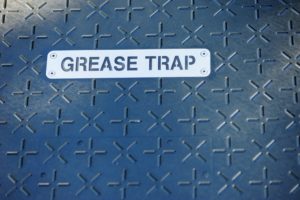
If you own a business that works with grease or fats, you probably already know that these substances can wreak havoc on your plumbing. In fact, the EPA estimates that grease is a major factor in 23,000 to 75,000 sanitary sewer overflows annually. That’s why it’s so important to have a grease maintenance plan in place, not just to comply with your states Fats, Oils, and Grease (FOG) regulations, but also to keep your business running smoothly. Using a grease trap is an effective way to help make sure these things are properly handled.
So, what is a grease trap? It’s a device that separates grease and other fatty waste out of your kitchen’s wastewater before it can reach your sewer or septic tank. There are different types of grease traps, but the basic model has two chambers. Water flows through the first chamber, where the grease is captured. As this fatty waste solidifies, it floats to the top of the first chamber, allowing the water to continue on into the second chamber.
Does your business need a grease trap? Any business that produces fat, oil, or grease in large quantities should have one. Examples of these businesses include restaurants, take-away outlets, bakeries and cafes, shopping centers with food, catering businesses, convenience stores, food manufacturing facilities, schools and colleges, and hospital and nursing home kitchens. If the volume of grease produced is high, the establishment will need a grease interceptor, while low-volume businesses will need a grease trap. These two devices are not exactly the same, but they perform the same basic function. The primary difference between them is their size. While your grease trap is probably small and located under your kitchen sink, a grease interceptor is much larger and is typically located underground and outside of the building.
Once you have a grease trap, it’s important to have a regular cleaning and maintenance schedule. Full grease traps are not as effective as clean traps when it comes to keeping grease out of your plumbing. Typically, you’ll need to have your grease trap cleaned every one to three months. Cleaning it frequently prevents the grease from hardening and becoming difficult to remove, so it saves you money to do it more often. Leaving it too long means it will take longer and cost more to have it cleaned. Staying on top of the maintenance, on the other hand, will keep your grease trap or interceptor working effectively and protect your plumbing from fatty waste.
When you need help cleaning out your grease trap, trust Trinity Liquid Waste. We perform grease trap cleaning and pumping, as well as routine maintenance to ensure your grease trap or interceptor is functioning properly. A family-owned business, we’ve been proudly serving customers throughout the Bay area for over 25 years. Specializing in residential and commercial septic and sewer services, our professional team provides exceptional service at affordable rates. Whether you need routine maintenance or 24-hour emergency service, we’re here for you. Call (510) 874-6489 or contact us through our website for more information.
